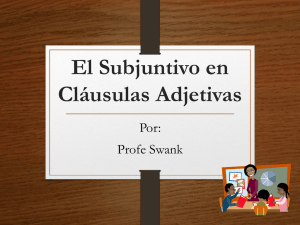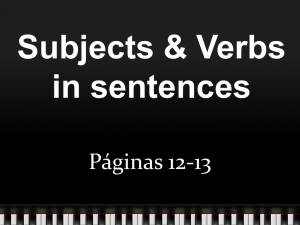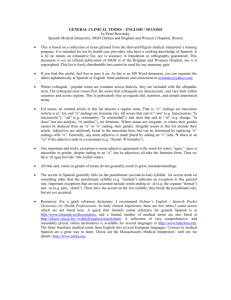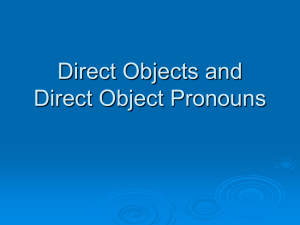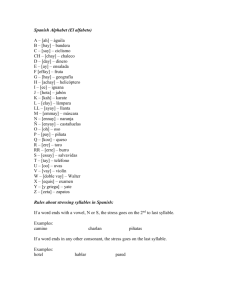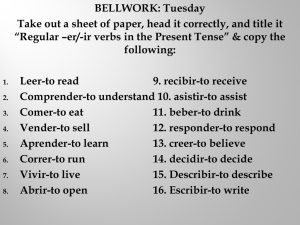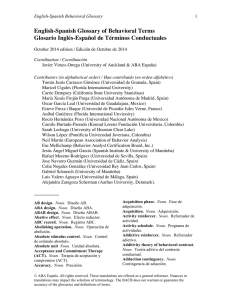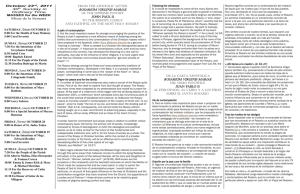1 SPAN III LECTURE NOTES. Understanding the subjunctive and
advertisement
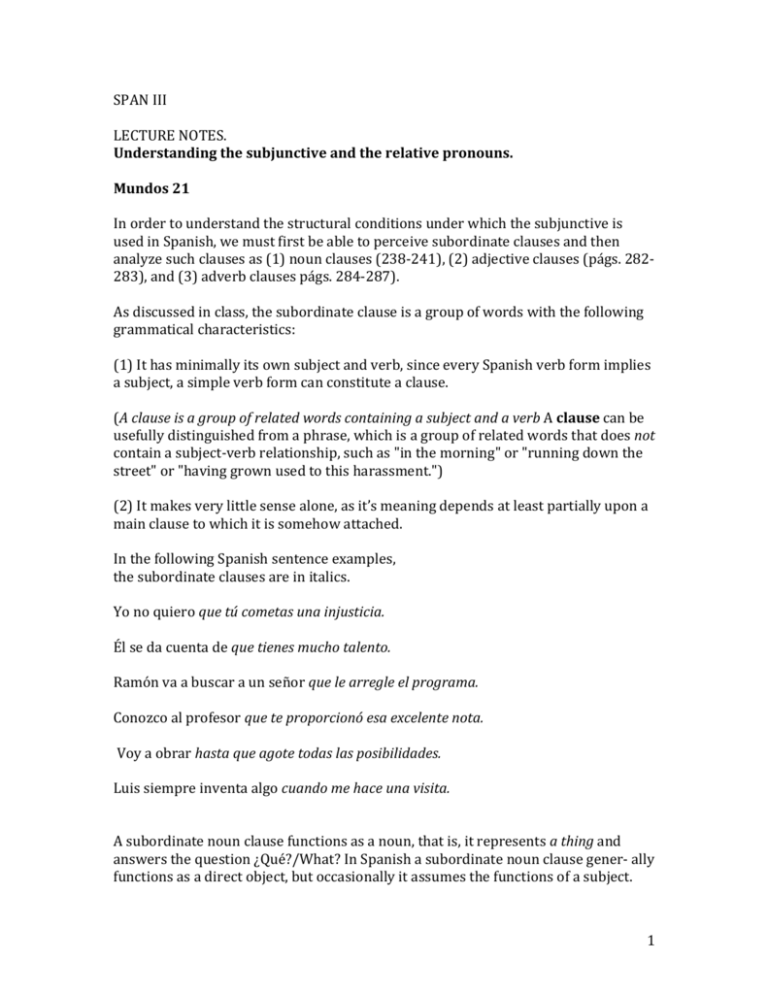
SPAN III LECTURE NOTES. Understanding the subjunctive and the relative pronouns. Mundos 21 In order to understand the structural conditions under which the subjunctive is used in Spanish, we must first be able to perceive subordinate clauses and then analyze such clauses as (1) noun clauses (238-­‐241), (2) adjective clauses (págs. 282-­‐ 283), and (3) adverb clauses págs. 284-­‐287). As discussed in class, the subordinate clause is a group of words with the following grammatical characteristics: (1) It has minimally its own subject and verb, since every Spanish verb form implies a subject, a simple verb form can constitute a clause. (A clause is a group of related words containing a subject and a verb A clause can be usefully distinguished from a phrase, which is a group of related words that does not contain a subject-­‐verb relationship, such as "in the morning" or "running down the street" or "having grown used to this harassment.") (2) It makes very little sense alone, as it’s meaning depends at least partially upon a main clause to which it is somehow attached. In the following Spanish sentence examples, the subordinate clauses are in italics. Yo no quiero que tú cometas una injusticia. Él se da cuenta de que tienes mucho talento. Ramón va a buscar a un señor que le arregle el programa. Conozco al profesor que te proporcionó esa excelente nota. Voy a obrar hasta que agote todas las posibilidades. Luis siempre inventa algo cuando me hace una visita. A subordinate noun clause functions as a noun, that is, it represents a thing and answers the question ¿Qué?/What? In Spanish a subordinate noun clause gener-­‐ ally functions as a direct object, but occasionally it assumes the functions of a subject. 1 In the following discussion, the noun clause, which is italicized, will be shown to represent a thing and to answer the question ¿Qué?/What? Yo quiero la paz. (La paz is a noun phrase which functions as a direct object. It is the thing 1want and answers the question ¿Qué quieres?) Yo quiero contribuir. (In this case, contribuir is the direct object even though it is a verb. It is the name of the action I want to do. Contribuir answers the question ¿Qué quieres?) Yo quiero que tú triunfes. (Here, the subordinate c1ause, que tú triunfes,is the thing I want. Although it is a c1ause, it is the direct object in this sentence. Since it is the thing I want, it is called a noun clause. This noun c1ause answers the question ¿Qué quieres?) Es importante que te superes. (This may be restated as Que te superes es importante. Nevertheless, que tú superes is still a noun c1ause in that it represents a thing and answers the question ¿Qué es importante? In this instance, however, the noun c1ause functions as a subject rather than as a direct object.) Types of dependent clauses: The three most common types of dependent clauses in Spanish are: 1 Noun clauses (cláusulas nominales or cláusulas sustantivas). In this case, the entire clause serves as a noun, usually as the direct object of a verb. It is normally introduced with the conjunction que [that]. [In Spanish, the subjunctive mood will be used in the noun clause when the verb that governs the clause is one of influence, emotion, doubt, or negation; the indicative is used when the governing verb is one of truth, certainty, reporting, or affirmation.] 2 Example: Quiero que vengas conmigo al concierto. I want you to come with me to the concert. 3 Adjectival clauses (cláusulas adjetivales). Here, the entire clause takes on the function of an adjective, usually modifying a noun or pronoun, the antecedent (antecedente). Adjectival clauses are normally introduced by a relative pronoun such as que [which/that] quien (who), el que (which/that/who), or el cual (which/that/who). [In Spanish, we use the subjunctive mood in adjectival clauses when the antecedent is indefinite, nonexistent, or negated; the indicative is used when the antecedent is known or definite.] 4 Example: Busco una secretaria que hable español. I'm looking for a secretary who speaks Spanish. 5 Adverbial clauses (cláusulas adverbiales). This type of clause is usually introduced by an adverbial conjunction, for example antes de que, cuando, mientras, or tan pronto como to list just a few. [The subjunctive is used for 2 adverbial clauses when the action or state in the clauses is anticipated —i.e., viewed as not yet happening— or hypothetical; the indicative is used when the action or state in the clause is viewed as a customary one or one which has been completed.] Example: Iremos tan pronto como llegue Juanita. We'll leave as soon as Juanita arrives. Practice in identifying the types of clauses. Underline the dependent clauses in the sentences given below and identify each as being a noun clause, adjectival clause, or adverbial clause, using an appropriate abbreviation such as noun, adj., or adv. Note: a sentence may contain more than one dependent clause, or none at all. 1 No me dijiste que ibas a Guatemala. 2 No he visto a nadie que sea tan generosa como ella. 3 Cuando me desperté me encontré en algo que parecía una selva. 4 Me gustó que usted nos lo explicara tan inteligentemente. 5 No vamos a hacer el viaje aunque reparemos el coche. 6 Yo lo creo todo porque tú me lo contaste. 7 Yo te daré la respuesta que buscas cuando me confieses qué hiciste anoche. 8 ¿Dónde está mi cámara, Manuel? 9 Antes de jugar, planeemos lo que vamos a hacer. Formas de los pronombres relativos RELATIVO EJEMPLO QUE (Puede ir acompañado por el artículo y las preposiciones) El hombre que me miró era mi tío. El chico del que me hablaste corría mucho. CUAL (EL CUAL, LA CUAL, LOS CUALES, LAS CUALES. Además pueden ir acompañados por preposiciones: CON EL CUAL, DEL CUAL, ETC...) QUIEN, QUIENES (Admite también El amigo del cual te hablé es ingeniero. Encontró una piedra en la cual había una inscripción. Las puertas por las cuales entramos estaban rotas. Los primos de quienes te hablé son maños. El presidente a quien me dirigí era turco preposiciones) CUYO, CUYOS (Admite algunas El niño a cuyos padres conozco no está. 3 REMEMBER! Cuyo: indica pertenencia, tiene género y número (cuyo, cuya, cuyos, cuyas). No es acorde con su palabra antecedente pero si con el sustantivo que le sigue. 4
